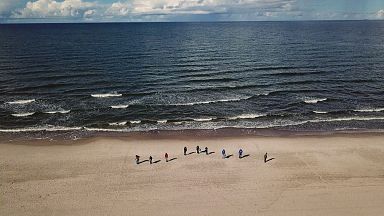Scientists mapping plastic pollution on the Latvian and Lithuanian coastline have discovered high levels of dangerous bacteria, called vibrio. A project largely funded by the European Cohesion Policy, called, ESMIC, has found 736 pieces of litter on 100 metres of beach.
A group of Latvian and Lithuanian scientists combs the border beach of Palanga. They are studying the accumulation of plastic and are participating in a European project called ESMIC, which maps, analyses, and provides data and methodology for dealing with this pollution. Their first conclusion is that algae act as a magnet for plastics.
"We found that three times more plastic items are there present in the beach wreck (algae) compared to the fresh or clean beach sand on the coastline," explains Arūnas Balčiūnas_,_ the Project Manager of ESMIC.
To map plastics, scientists use several techniques, including drone imaging. This data is then compared with satellite images. This is how they determine which areas are most affected and the volume of algae and plastic that could help the municipalities. It is also of interest to the Lithuanian and Latvian authorities.
We are using three levels, three dimensions of the methods in situ like we are collecting it by hand, drones that can see smaller patches, and can be much more fast and operational, and the satellites that can take all the Baltic Sea," says Diana Vaičiūtè, the lead scientist and remote sensing expert.
Lithuania and Latvia accumulate more seaweed (algae) and plastic than other Baltic Sea countries because of their geographical location - they are situated on the eastern side of this relatively closed sea - and the strong prevailing winds.
For this project, 449,574 euros were budgeted, of which 85% were financed by the European Cohesion Policy, and the remaining 15% was made by the participating project partners: Klaipėda University; Latvian Institute of Aquatic Ecology; Agency of Daugavpils University; Klaipėda Science and Technology Park; Foundation for Environmental Education.
In Klaipeda University's laboratories, scientists complete the study by analysing samples of plastics and microplastics present in algae and water. They are looking for vibrio, a type of bacteria that can be dangerous for humans, especially on this coastline, also called the Amber Coast. Their analyses suggested vibrio is present in 67% of cases.
"Due to climate change, the vibrio coastal infections are increasing in the Baltic Sea region and plastic is one of the ways how those bacteria might be transported. So and people are digging this algae for amber. And by this way, they can be exposed to potentially pathogenic bacteria," describesMarija Kataržytė, the senior scientist, and microbiologist.
Every time the scientists collect their samples they show passers-by what they find on the beach. This outreach work has now collected 736 pieces of litter found in 100 metres of beach. This is 36 times the limit considered to be a "sufficient level of precaution" in Europe.












